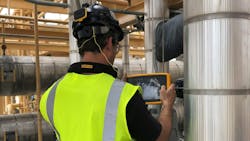Acoustic imaging key in leak detection and downtime reduction
Hidden leaks in equipment are the nemeses of every manufacturing plant operator. Beyond performance issues and reduced energy efficiency, the damage caused by unnoticed gas or compressed air leaks can be substantial, wreaking havoc on equipment, resulting in downtime and significant costs. To prevent these issues, regular maintenance and the use of acoustic imaging technology can be beneficial in detecting, identifying and fixing these hidden leaks, ultimately reducing costly downtime and improving operational efficiency.
How acoustic imaging works
Acoustic imaging can be a game changer in detecting leaks. It offers a host of benefits in that it provides versatile, quick and accurate detection, is safe and non-invasive, and provides operational continuity. Acoustic imaging uses an acoustical array of tiny super-sensitive microphones that detect both sonic and ultrasonic sound waves. The acoustic imager recognizes a sound source at a potential leak location and then it applies proprietary algorithms that interpret the sound as a leak. The results produce a color map superimposed over the visible light image — showing exactly where the leak is. The results are displayed on a screen as a still image or a real-time video.
Large areas can be scanned quickly which helps locate leaks much faster than other methods. It also allows for filtering on intensity and frequency ranges. One example of an acoustic imager in action: a team at a large manufacturing plant recently used two units to locate 80 compressed air leaks in one day. The maintenance manager said it would have taken them weeks to find that number of leaks using traditional methods. By finding and fixing leaks quickly, the crew also saved potential downtime, which at this plant can cost an estimated $100,000 an hour in lost productivity.
Benefits of acoustic imaging to detect leaks
Through the use of acoustic imaging to locate hidden leaks, manufacturing facilities can avoid some of the more costly issues. The following are some examples of issues that acoustic imaging helped visualize to quickly repair:
- Control air pressure regulator failure. A control air pressure regulator is intended to keep internal components dry. Through use of the acoustic imager, an operator was able to visualize two leaks, which were caused by bad seals.
- Process control valve condensation. In the case of an unfounded electrical failure, it turned out the root cause was not electrical. The acoustic imager identified a compressed air dryer that was not operating efficiently, which caused condensation in the area and eventually caused the electrical components to fail.
- Pressure regulator corrosion. A user had a pressure regulator that kept failing, but the root cause could not be determined. An acoustic imager pinpointed small carbon dioxide leaks nearby which over time can cause components to break, negatively impacting uptime and/or quality.
- Air line leaks reduce performance. Leaks in pneumatic systems are a quality defect that can impact the performance of onboard systems. Acoustic imaging can find these leaks more quickly than conventional methods of leak detection, which can easily miss these types of leaks.
- Product reservoir leaks. Acoustic imaging can identify leaks such as these, which can impact batch integrity, such as contamination of the product due to infiltration of environmental particulates.
- Dust collection system leaks lead to inefficient performance. Acoustic imaging can identify leaks in dust collection systems, which can cause inefficient operation and could lead to added maintenance or reduced performance or blocks.
- Control air regulator not venting properly. When a gasket between the two mounting surfaces failed, acoustic imaging helped prove the device was not venting excess pressure, but simply leaking.
- Robotics leaks that impact product quality. Oftentimes when suction issues are reported all components are replaced because it is difficult to isolate the problem. However, using acoustic imaging can allow operators to check each cup independently to check for leaks instead of costly replacement of all the components.
- Steam system leaks are expensive. Steam systems are often inaccessible, making it difficult to identify issues. Air or gas leaks can be difficult to identify, especially if you do not know where to look. The use of acoustic imaging can easily identify these and other types of air or gas leaks to keep systems up and running efficiently.
Acoustic imaging can go a long way in quickly and cost-efficiently identifying and repairing leaks, saving companies in downtime while making needed repairs. Choosing the right acoustic imaging technology can significantly impact leak detection and functional efficiency. When selecting an acoustic imager, look for the right acoustic imager based on your environment and specific needs. And be sure to consider these core acoustic imaging attributes: frequency range (in Hertz), distance (in feet or meters), minimum frame rate and reporting functionality.
Justin Sheard is a senior engineer and application specialist with the Fluke Industrial Imaging group. He has more than 20 years of experience designing handheld electronic products. While holding leadership roles in the development of Fluke thermal imagers, Sheard accumulated more than 10 patents. In his current position as application specialist, Sheard works directly with customers offering training and application support while learning about their workflows and daily challenges.
Fluke
About the Author
Justin Sheard
Senior engineer and application specialist with the Fluke Industrial Imaging group
Justin Sheard is a senior engineer and application specialist with the Fluke Industrial Imaging group (www.fluke.com). He has more than 20 years of experience designing handheld electronic products. While holding leadership roles in the development of Fluke thermal imagers, Sheard accumulated more than 10 patents. In his current position as application specialist, Sheard works directly with customers offering training and application support while learning about their workflows and daily challenges. Sheard holds a Master of Science in Mechanical Engineering from University of Minnesota and a Bachelor of Science in Physics from Bethel University.

